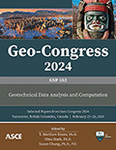A Discrete Element Method-Based Simulation of a Block Toppling Failure on an Inclined Surface
Publication: Geo-Congress 2024
ABSTRACT
The particle-based discrete element method is used to simulate a block’s failure on an inclined surface. The particles were generated in polygons and bonded using a parallel bond model to simulate blocks with different width-to-length ratios on an inclined surface. The size of the particles can influence block movement (e.g., toppling or sliding) on the inclined surface. By decreasing the particle size, the interlocking forces between the particles are reduced, and slip occurs between the block and inclined surface. Reducing the particle size, however, increases the analysis time, especially when the number of particles is too high. Introducing smooth joints eliminates the effect of overriding particles (dilation) caused by local particle orientations. As a result, the effect of the two surfaces’ asperities will be removed, especially when larger particles are utilized to reduce the analysis time.
Get full access to this article
View all available purchase options and get full access to this chapter.
REFERENCES
Ashby, J. (1971). Sliding and toppling modes of failure in models and jointed rock slopes, M.Sc. thesis, London University, Imperial College.
De Freitas, M., and Watters, R. (1973). “Some field examples of toppling failure.” Geotechnique, 23(4), 495–513.
Goodman, R. E. (2013). “Toppling--A Fundamental Failure Mode in Discontinuous Materials---Description and Analysis.” Geo-Congress 2013: Stability and Performance of Slopes and Embankments III, 2338–2368.
ICG (Itasca Consulting Group Inc). (2004). Particle Flow Code (PFC) (2D Version 3.1 Manual). Minneapolis, MN, USA.
Mas Ivars, D., Potyondy, D., Pierce, M., and Cundall, P. (2008). “The Smooth-Joint Contact Model. Proceedings of the WCCM8-ECCOMAS, Venice, Italy.
Mishra, B. K. (2003). “A review of computer simulation of tumbling mills by the discrete element method: Part I—contact mechanics.” International Journal of Mineral Processing, 71(1–4), 73–93.
Müller, L. (1968). “New considerations on the Vaiont slide.” Rock Mechanics & Engineering Geology, 6(1/2), 4–91.
Munjiza, A. (2004). The Combined Finite-Discrete Element Method. John Wiley & Sons Ltd, England.
O’Sullivan, C. (2011). Particulate Discrete Element Modelling: A Geomechanics Perspective. Spon Press/Taylor & Francis.
PFC3D, User’s Manual. (2016). Itasca Consulting Group (ICG), Minneapolis, MN, USA.
Pierce, M., Mas Ivars, D., and Sainsbury, B.-A. (2009). “Use of Synthetic Rock Masses (SRM) to Investigate Jointed Rock Mass Strength and Deformation Behavior.” Proceedings of the International Conference on Rock Joints and Jointed Rock Masses, 1–6.
Pierce, M., Cundall, P., Potyondy, D., and Ivars, D. M. (2007). “A synthetic rock mass model for jointed rock.” 1st Canada-US Rock Mechanics Symposium, OnePetro.
Potyondy, D., and Cundall, P. A. (2004). “A Bonded-Particle Model for Rock.” International Journal of Rock Mechanics and Mining Sciences, 41, 1329–1364.
Sagaseta, C. (1986). “On the modes of instability of a rigid block on an inclined plane.” Rock Mechanics and Rock Engineering, 19(4), 261–266.
Zsaki, A. (2009). “An efficient method for packing polygonal domains with disks for 2D discrete element simulation.” Computers and Geotechnics, 36(4), 568–576.
Information & Authors
Information
Published In
History
Published online: Feb 22, 2024
ASCE Technical Topics:
- Analysis (by type)
- Bonding
- Continuum mechanics
- Deformation (mechanics)
- Discrete element method
- Earth materials
- Engineering fundamentals
- Engineering materials (by type)
- Engineering mechanics
- Failure analysis
- Geomaterials
- Geotechnical engineering
- Joints
- Materials engineering
- Materials processing
- Methodology (by type)
- Models (by type)
- Numerical methods
- Particle size distribution
- Particles
- Simulation models
- Sliding effects
- Solid mechanics
- Structural engineering
- Structural mechanics
- Structural members
- Structural systems
Authors
Metrics & Citations
Metrics
Citations
Download citation
If you have the appropriate software installed, you can download article citation data to the citation manager of your choice. Simply select your manager software from the list below and click Download.
